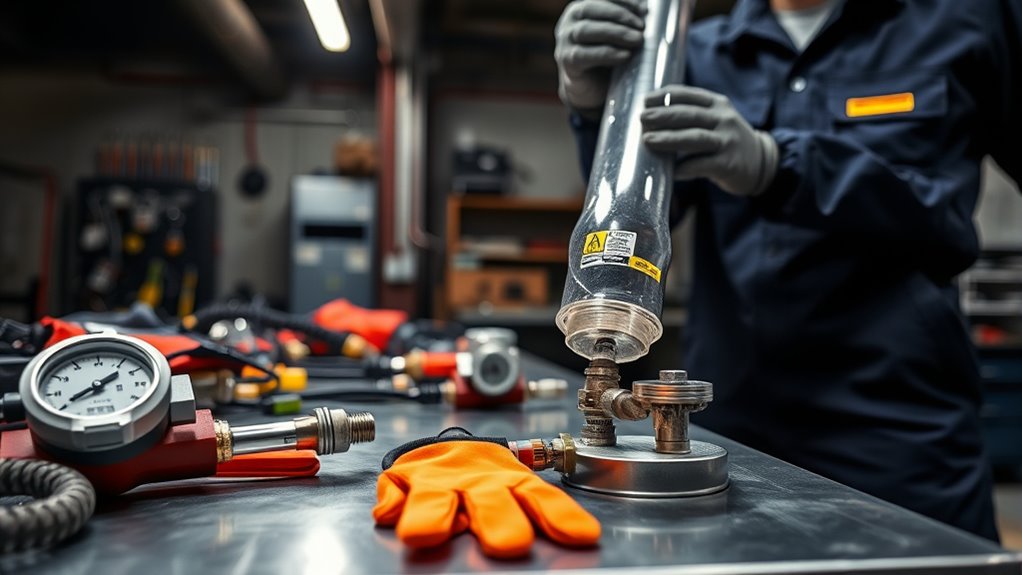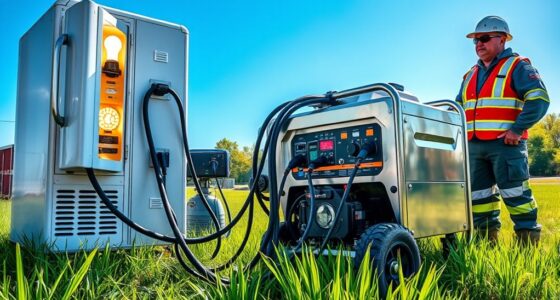To stay safe from carbon monoxide and exhaust hazards, install reliable CO detectors on every floor and near sleeping areas, and regularly test them. Maintain all fuel-burning appliances and guarantee proper ventilation during use. Always operate generators, heaters, and vehicles outdoors and away from vents or windows. Recognize symptoms of CO poisoning early and have an emergency plan. Staying alert and following safety practices can prevent accidents and long-term health issues—learn more to protect yourself and others.
Key Takeaways
- Install and regularly test CO alarms near sleeping areas and on every floor to ensure early detection.
- Maintain fuel-burning appliances and vent systems to prevent leaks and reduce indoor CO buildup.
- Recognize symptoms of CO poisoning early, such as headaches and dizziness, and seek immediate medical attention.
- Operate generators, heaters, and equipment outdoors, at least 20 feet from windows and vents, to prevent indoor CO accumulation.
- Educate household members and workers on safe equipment use, emergency protocols, and the importance of ventilation and CO detection.
Understanding Carbon Monoxide and Its Common Sources
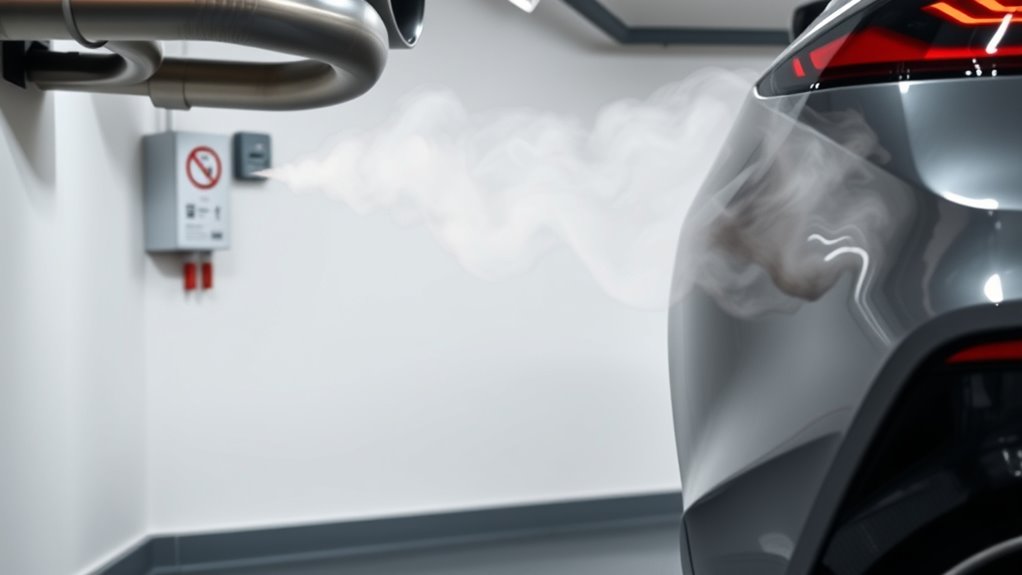
Have you ever wondered how invisible, odorless gases like carbon monoxide (CO) can pose serious health risks? CO is a colorless, tasteless gas that forms during incomplete combustion of fuels like natural gas, gasoline, wood, coal, and propane. It’s produced in vehicles, machinery, power plants, wildfires, and incinerators, both outdoors and indoors. Inside your home, appliances such as furnaces, water heaters, gas stoves, fireplaces, and dryers can emit CO if they’re malfunctioning or not properly vented. Outdoor sources include vehicle exhaust, lawn equipment, and generators, especially in enclosed spaces. Smoke from wildfires and gas leaks also contribute to CO levels. Because CO is undetectable without sensors, understanding these common sources helps you recognize potential risks and take preventive steps. Monitoring CO levels with alarms is crucial, especially during the winter months when heating appliances are in constant use. Additionally, awareness of AI-driven safety monitoring systems can enhance early detection and prevention efforts.
Recognizing the Symptoms and Health Risks of CO Poisoning
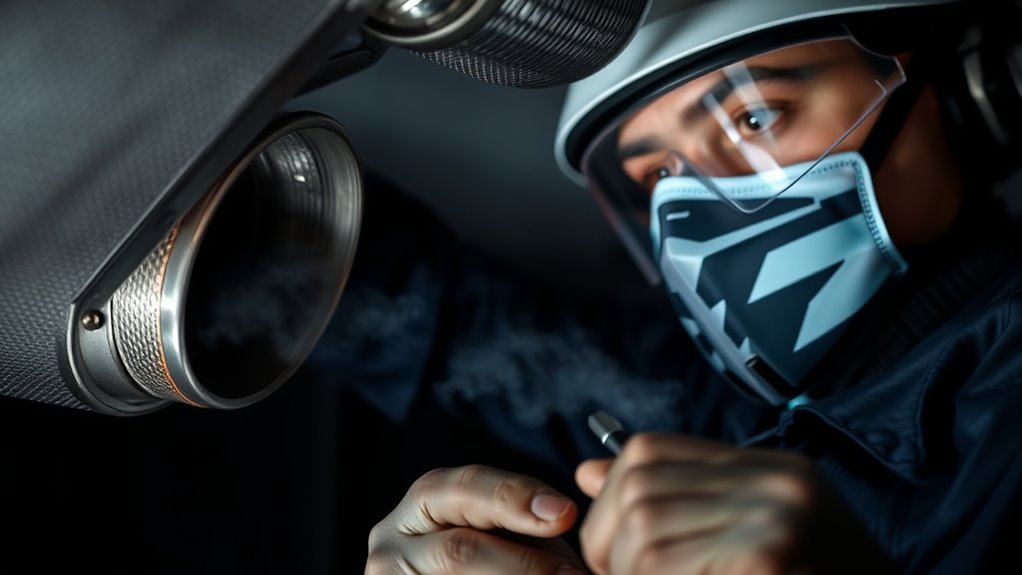
You need to be alert for early signs of CO poisoning, like headaches, dizziness, and nausea, which can easily be mistaken for common illnesses. As exposure increases, symptoms may worsen to confusion, chest pain, or loss of consciousness, posing serious health risks. Long-term effects, including memory loss and neurological issues, can develop even after initial symptoms fade if the poisoning isn’t treated promptly. Carbon monoxide is an odorless, dangerous gas that can cause death if inhaled in high enough concentrations, emphasizing the importance of prompt recognition and response.
Common Symptoms to Watch
Recognizing the symptoms of carbon monoxide (CO) poisoning is essential for prompt intervention, as early signs can often be subtle and easily mistaken for other illnesses. The most common initial symptom is a headache, often accompanied by dizziness, poor coordination, and fatigue. Nausea, vomiting, and stomach upset may also occur early on. You might notice irritability, confusion, or memory problems, signaling neurological effects. Respiratory symptoms include shortness of breath, rapid breathing, and chest pain, especially if you have underlying health issues. Cardiovascular signs, like a racing heartbeat or low blood pressure, can develop with increased exposure. Watch for changes in mental clarity, drowsiness, blurred vision, or muscle control loss. Pets and vulnerable populations may show symptoms sooner, emphasizing the importance of quick recognition. Immediate action is crucial to prevent serious health consequences. Being aware of exposure risks can help in early detection and prevention.
Effects of High Exposure
High levels of carbon monoxide exposure can cause rapid and severe health effects that require immediate attention. You might lose consciousness within minutes, and very high concentrations can lead to coma or death without help. Neurological symptoms include confusion, dizziness, and loss of coordination, worsening as oxygen deprivation continues. Cardiopulmonary symptoms like rapid heartbeat, chest pain, and breathing difficulties also occur. Here’s a quick overview:
| Effect | Symptoms/Signs |
|---|---|
| Neurological | Confusion, seizures, coma |
| Cardiopulmonary | Chest pain, irregular heartbeat |
| Systemic & Metabolic | Fatigue, nausea, fainting |
Recognize these signs early to prevent severe injury or death. Immediate medical attention is vital. Persistent exposure can lead to long-term neurological problems, including memory loss and difficulty concentrating, so prompt treatment is crucial. Additionally, understanding the health risks associated with CO poisoning emphasizes the importance of proper safety measures to prevent exposure.
Long-Term Health Consequences
Long-term health consequences of carbon monoxide poisoning can be severe and sometimes appear long after initial exposure. You may experience lasting brain damage that affects your memory, speech, and thinking skills. Delayed neurological issues can develop days or weeks later due to nerve damage, impairing electrical signal transmission. Damage to the basal ganglia might cause movement problems resembling Parkinson’s disease, with tremors and difficulty moving. You could also face persistent symptoms like amnesia, mood swings, irritability, or speech difficulties. Physical health risks include organ damage, headaches, weakness, and increased chances of stroke or heart problems. Long-term exposure can lead to depression, personality changes, and cognitive decline, impacting your daily life, work, and safety. Recognizing these symptoms early is vital for seeking proper treatment. Early intervention can significantly improve outcomes and reduce the severity of long-term complications. Additionally, ongoing monitoring and medical follow-up are essential to address any emerging issues promptly.
Essential Maintenance and Inspection of Fuel-Burning Appliances
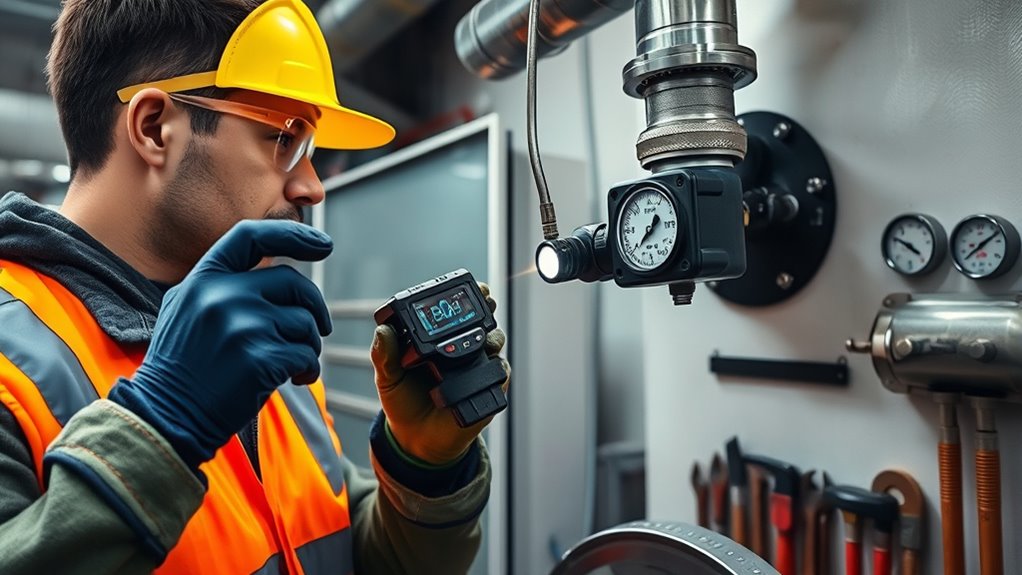
Regular inspection and maintenance of fuel-burning appliances are essential for safe and efficient operation. You should regularly check for signs of wear, rust, corrosion, or physical damage, and inspect all gas lines, pipes, and fittings for leaks or looseness using leak detectors or soapy water. Look for soot, scorch marks, moisture, or discoloration around appliances and vents, and ensure vent pipes are properly aligned, secure, and free of obstructions. Check pilot lights and burners for steady, blue flames; clean or replace parts if flames are yellow or flickering. Clean burners, filters, and internal components regularly to optimize combustion and airflow. Test safety controls, adjust gas pressures, and verify ignition systems. Inspect vents, flues, and chimneys for damage or blockages to maintain proper exhaust flow. Keep detailed records and schedule professional inspections annually. Regularly performing preventive maintenance can help identify potential issues early, saving you time and money. Being aware of emotional regulation issues can also help in maintaining a safer environment, especially if there are individuals with BPD in your household.]
The Critical Role of CO Detectors and Monitoring Devices
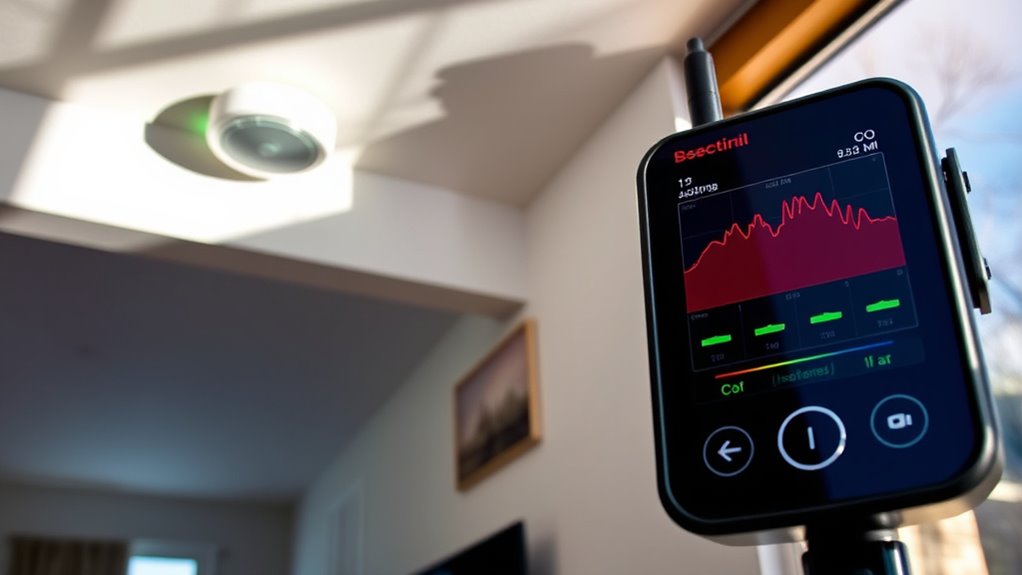
Ensuring your home’s safety involves more than just maintaining appliances; it also requires effective detection of hazardous gases like carbon monoxide. CO detectors and monitoring devices provide critical early warnings, helping you act before danger arises. There are various types, including biomimetic sensors, electrochemical detectors, and combo alarms with smoke detection. Digital displays show real-time CO levels, while voice alerts guide you during emergencies. Smart home integrations enable remote monitoring, and batteries or hardwiring guarantee continuous operation. Proper placement near sleeping areas and away from False alarm sources is essential. Regular testing and maintenance guarantee reliable performance. Understanding local laws can also influence the selection and placement of detectors to ensure compliance and maximum safety. Here’s a quick overview:
| Type | Key Feature |
|---|---|
| Biomimetic | Mimics hemoglobin, lasts 6 years |
| Electrochemical | High accuracy, 5–10 years lifespan |
| Digital | Real-time display, peak recording |
| Combo (CO + Smoke) | Dual hazard detection, voice alerts |
| Battery/Hardwired | Ensures operation during outages |
Safe Practices When Using Generators, Heaters, and Equipment
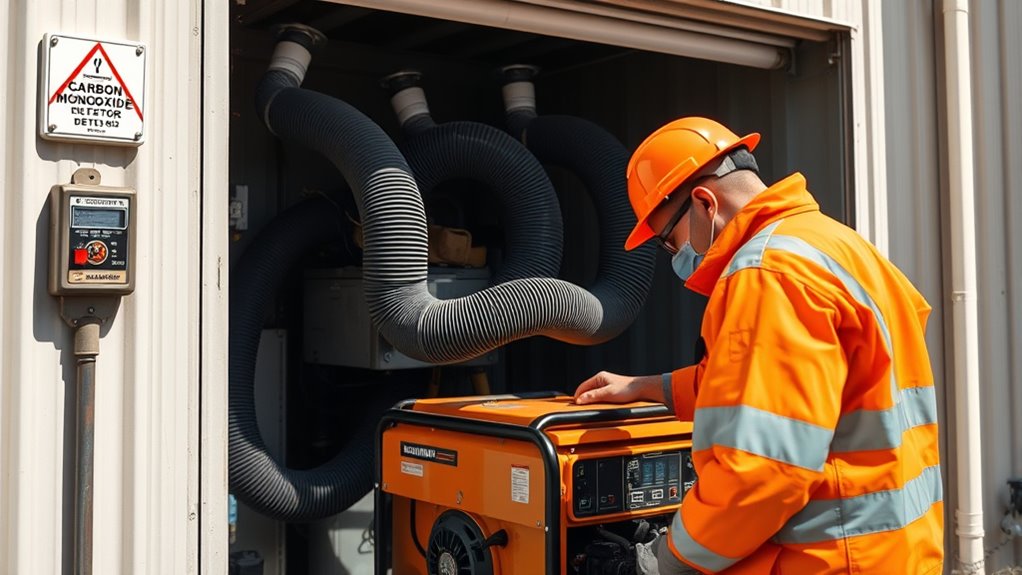
Using generators, heaters, and other equipment safely requires careful attention to placement, operation, and maintenance to prevent carbon monoxide buildup and fire hazards. To stay safe, keep these practices in mind:
- Operate generators outdoors only, at least 20 feet away from windows, doors, and vents. Maintain 3 to 4 feet of clearance around the unit for ventilation, and never rely on fans or open windows for CO dispersal.
- Use heavy-duty, outdoor-rated extension cords rated for your load, and avoid overloading or backfeeding your home. Turn off the generator and let it cool before refueling.
- Regularly inspect your equipment for damage, and follow manufacturer instructions for proper grounding and operation. Store fuel outside living areas and keep emergency numbers handy.
- Ensure proper ventilation in your setup area to prevent dangerous buildup of carbon monoxide and maintain safe operation conditions.
Special Safety Tips for Vehicles, Boats, and Recreational Spaces
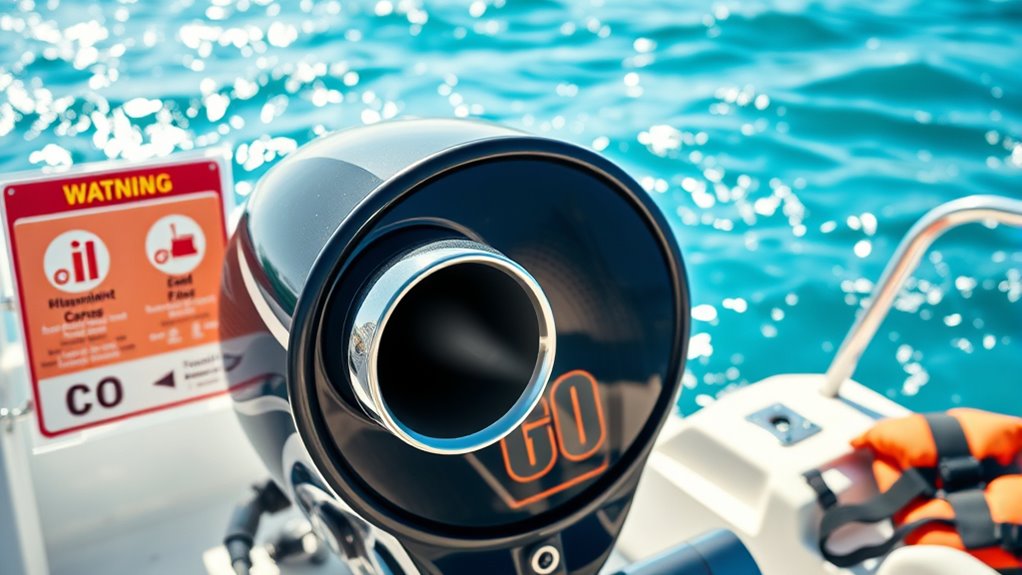
To stay safe around vehicles, boats, and recreational spaces, you need to understand the risks of carbon monoxide buildup from engines and generators. Always guarantee proper ventilation, keep exhaust systems maintained, and avoid running engines in enclosed areas. CO is odorless and colorless, making it especially important to use detectors and be aware of symptoms of poisoning. Recognizing family photoshoot fails can also help you prepare better for outdoor activities. By following these tips, you can prevent dangerous CO exposure and protect everyone around you.
Vehicle Engine Risks
Vehicle engine risks are a serious concern, especially in enclosed or poorly ventilated spaces. CO from engines can quickly reach dangerous levels, causing unconsciousness or even death within minutes. You must be aware of these dangers:
- Running engines inside garages or enclosed areas can cause rapid CO buildup, risking poisoning.
- Regularly inspect exhaust systems for leaks or blockages to prevent excess emissions.
- Ensure proper ventilation when operating engines indoors, and install CO detectors for early warning.
- Proper maintenance of exhaust systems can significantly reduce the risk of CO leaks, helping to prevent hazardous buildup.
- Being aware of engine emissions is crucial, as even small leaks can lead to dangerous CO accumulation in enclosed spaces.
Since CO is tasteless, odorless, and colorless, you might not notice danger without monitoring devices. Prolonged exposure, even in open areas under certain weather conditions, can cause serious health issues. Staying vigilant and following safety measures is essential to prevent deadly CO accumulation.
Safe Boating Practices
Ensuring safety while boating requires careful attention to practices that protect you and your passengers. Always wear a life jacket, especially on vessels under 21 feet, to greatly reduce drowning risk. Stay alert and avoid distractions, maintaining a proper lookout at all times. Never operate a boat under the influence of alcohol; alcohol impairs judgment and reaction time, increasing accident chances. Get proper boating safety instruction—most fatalities involve inexperience or lack of knowledge—and take courses to improve skills. Regularly check your vessel’s equipment and machinery to prevent failures. Maintain safe speeds, follow navigation rules, and use safety devices like radios and flares. Be aware of environmental conditions and boat responsibly, especially during peak seasons when accidents are more frequent. Additionally, understanding and implementing safe boating practices can significantly reduce the risk of accidents and enhance overall safety on the water.
Emergency Response Steps for CO Exposure Incidents
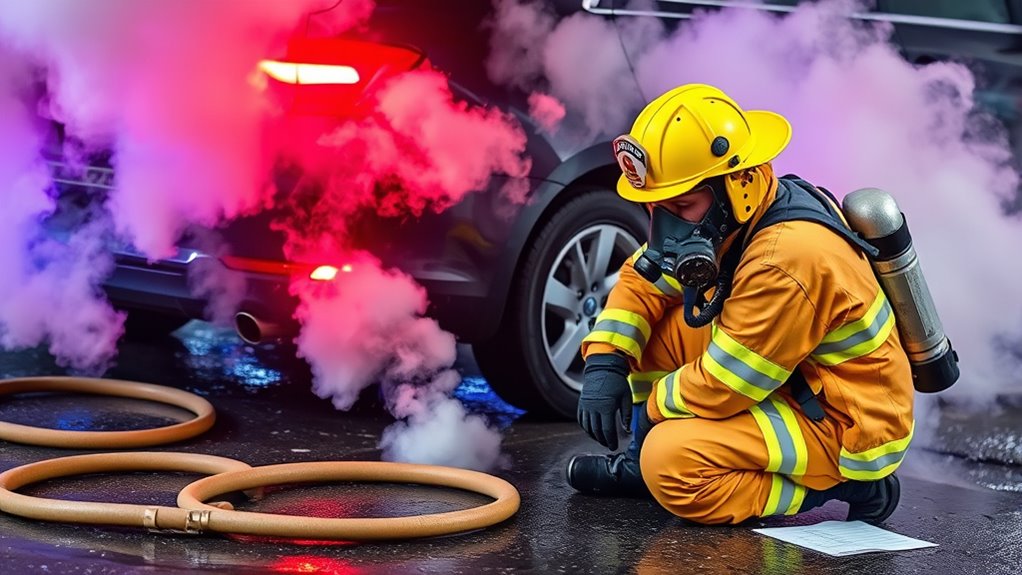
When you suspect or detect carbon monoxide presence, the immediate priority is to evacuate the area without delay and move everyone to fresh air outdoors or near an open window or door. Once outside, follow these steps:
- Ensure all occupants are accounted for and prevent reentry until safety is confirmed by qualified personnel.
- Turn off all combustion appliances to stop further CO production, if safe to do so.
- Call 911 or emergency medical services immediately to report the incident and request assistance.
- Verify the environment for additional hazards such as fire or other toxic substances to ensure scene safety before entering or providing further aid. Recognizing the importance of indoor safety measures can help prevent future incidents and protect everyone involved.
While waiting for help, open doors and windows to ventilate the premises if it’s safe. Remember, quick action can save lives, so stay calm and prioritize evacuation and communication.
Practical Tips for Workplace and Construction Site Safety
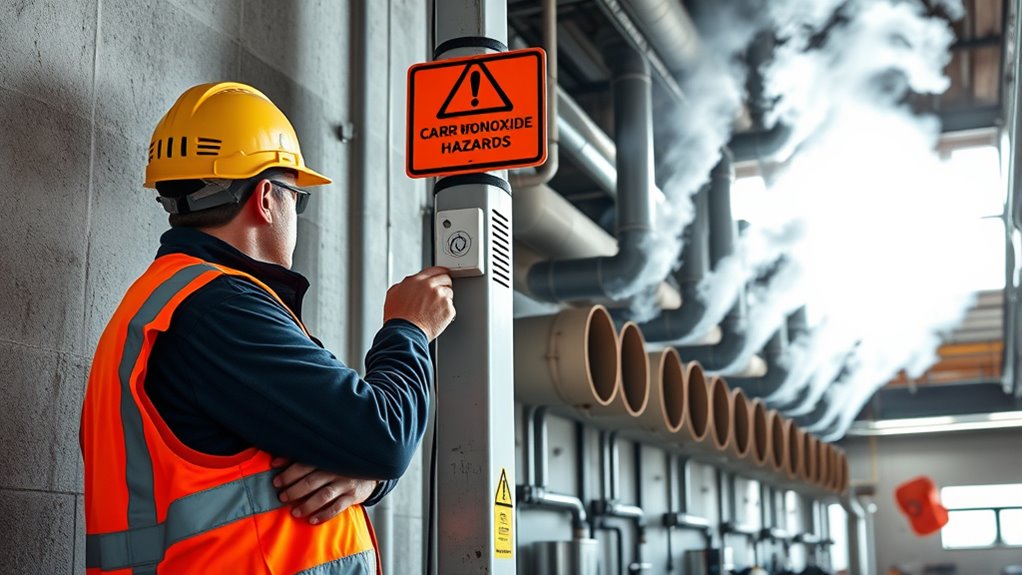
Effective management of carbon monoxide hazards on worksites starts with implementing practical safety measures. You should install effective ventilation systems to remove CO from breathing zones, especially in confined spaces. Replacing gasoline- or diesel-powered equipment with battery-powered options helps eliminate emissions. Regularly maintain engines and combustion appliances to prevent CO buildup. Use local exhaust ventilation and portable devices in enclosed or underground areas. Monitor ambient air frequently with personal CO detectors and instruments like infrared analyzers for real-time readings. Test oxygen levels in confined spaces before entry to ensure safety. Always keep emergency respirators, such as SCBA, nearby for high CO levels. Educate workers about CO sources, symptoms, and control measures, and enforce procedures for reporting hazards. Utilizing self-watering plant pots can also help maintain optimal humidity levels and reduce the need for frequent watering, which indirectly supports a healthier work environment. These steps greatly reduce the risk of CO poisoning on your site.
How to Protect Your Family and COmmunity From CO Hazards
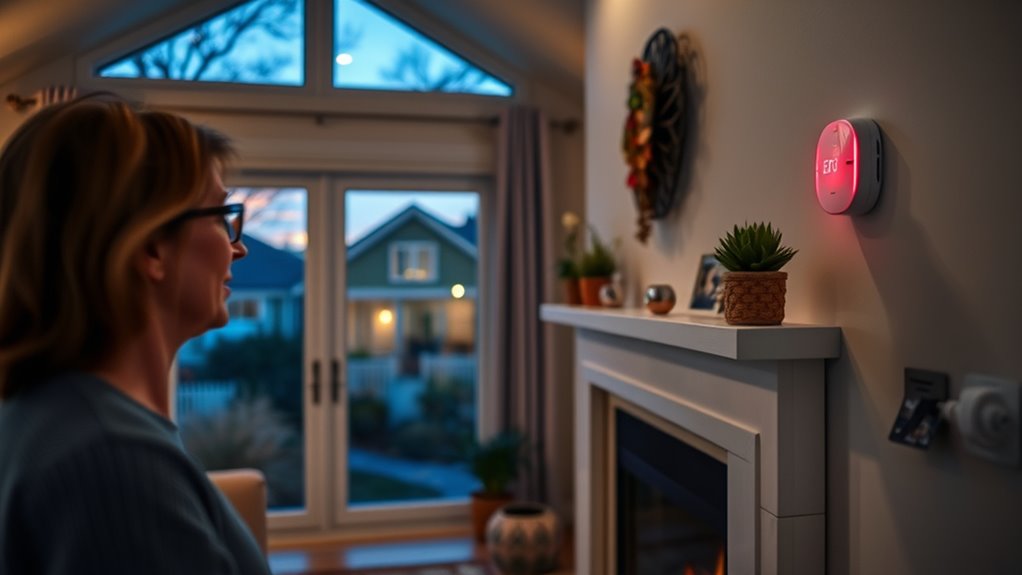
Protecting your family and community from carbon monoxide (CO) hazards starts with awareness and proactive measures. Since CO is odorless and invisible, having alarms is essential.
Here are three key steps:
- Install CO alarms on every floor, near sleeping areas, and keep them maintained.
- Regularly service all fuel-burning appliances like furnaces, water heaters, and stoves to prevent leaks.
- Never operate generators, grills, or power tools indoors or near open windows and doors.
- Be aware that gelato shops and similar establishments often use refrigeration units that require proper maintenance to prevent leaks, which can contribute to indoor air quality issues.
Additionally, avoid running vehicles or gasoline-powered equipment inside garages, even with the door open. Develop a family emergency plan that includes recognizing CO alarm sounds and symptoms of poisoning. Community awareness and adherence to safety practices save lives.
Frequently Asked Questions
How Can I Tell if My Indoor Air Has Dangerous CO Levels?
You can tell if your indoor air has dangerous CO levels by installing and maintaining CO detectors near sleeping areas and fuel-burning appliances. These detectors will sound an alarm if CO levels become hazardous. Remember, symptoms like headaches, dizziness, or nausea may occur before alarms go off. Regularly test your detectors and guarantee proper placement, especially near garages and vents, to catch elevated CO early and keep your home safe.
Are There Differences Between Residential and Workplace CO Detection Requirements?
Yes, there are distinct differences between residential and workplace CO detection requirements. Residential detectors prioritize simplicity, sounding alarms at 70 ppm to prevent acute poisoning, and are often required on every floor and near fuel sources. Workplace monitors, however, focus on continuous, real-time readings, often alarm at lower levels like 20 ppm, and are carefully placed around potential CO sources to guarantee ongoing occupational safety and compliance.
What Are the Long-Term Health Effects of Low-Level CO Exposure?
Long-term low-level CO exposure can cause persistent neurological issues like memory loss, concentration problems, and vision difficulties. You might experience mood changes, depression, or irritability, which can last years after exposure. It can also impair your cardiovascular health, leading to chest pain, arrhythmias, and reduced oxygen delivery to crucial organs. Vulnerable groups like infants and pregnant women are at higher risk for severe effects, including developmental delays or fetal damage.
How Often Should CO Alarms or Monitors Be Tested and Replaced?
Think of your safety gear as a loyal guard, always alert. You should test your CO alarms monthly by pressing the test button, ensuring they’re ready to alert you. Replace them every 5 to 10 years, or when they fail tests, show damage, or the manufacturer recommends. Regularly clean and maintain your alarms to keep their senses sharp, preventing silent dangers from slipping past unnoticed.
Can CO Poisoning Occur Without Noticeable Symptoms?
Yes, CO poisoning can happen without noticeable symptoms because carbon monoxide is colorless, odorless, and tasteless. You might be exposed without realizing it, especially if you’re asleep, intoxicated, or if symptoms are mild and mistaken for other illnesses. Pets might show signs first, but humans often remain unaware until severe symptoms occur. Installing CO detectors and ensuring proper ventilation are essential to catch silent exposure early.
Conclusion
So, next time you’re tempted to ignore those warning signs or skip maintenance, remember: CO is the silent killer you can’t see or smell. It’s ironic how something so invisible can pose such a deadly threat—yet, with just a little attention and proper safety measures, you can keep yourself and your loved ones safe. Don’t let negligence turn your home into a silent danger zone; stay vigilant and breathe easy.

